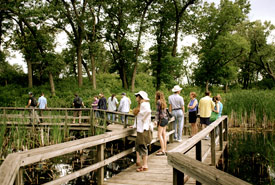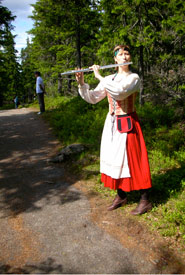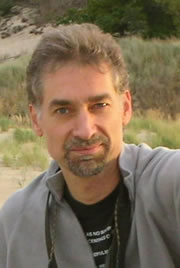How to soundwalk (Part Two)

Soundwalk in Miller Woods, Indiana Dunes National Lakeshore, July 2010. (Photo by Noé Cuéllar)
In my last post I introduced the idea of soundwalking and briefly touched on its benefits. In this post I offer my advice on how to actually conduct a soundwalk.
How to organize and lead soundwalks
Identify a place and plan a route. R. Murray Schafer’s Tuning of the World provides classic examples of maps. With ubiquitous mobile computing devices such as a smartphone, one can log GPS coordinates to produce and share a map in advance of the event. Consider what sounds will constitute this soundscape. Will the soundwalk include sounds of nature and the built environment? Use identifiers to name them. Where and when are they happening? Provide prompts for participants to keep them mindful and alert.
In addition to noticing how many sounds are around or how they make us feel, I find it useful to provide a few terms to describe familiar features of any soundscape. Having a name for the mood or experience makes it both memorable and accessible for sharing and learning. Like the term "soundscape" itself, Schafer’s terms are readily understood and helpful. "Keynote," "soundmark" and "signal" are three favorites.
Keynote denotes the ambient tone that often lies below awareness not because it inaudible but because our nervous system naturally tunes out continuous and unchanging sounds and other sensory input, for example the steady hum of distant traffic or the AC mains.
A soundmark is similar to a landmark: a sound that’s unique to the place where it is made. It may help mark the identity of the community that resides in that place with its sound.
While a keynote comprises the background of a soundscape, a sound signal occupies its foreground, sending messages. For example, your dog telling you it’s time for a walk or your alarm clock.
Much of our experience of the soundscape is acousmatic, meaning the sources of the sounds we hear are out of sight. This is especially true in wooded areas, where wildlife is audibly active but hidden visually. In such areas, animals are likely to be more aware of your approach and disappear silently for their own safety. Exceptions to that rule will be when animals sound warnings to keep intruders away.
A wealth of additional, intriguing, and very useful terms are provided in Sonic Experience by Francois Augoyard and Henry Torgue. With these descriptive terms a soundwalker can discover a heightened sense of what and where sounds are and what they mean. This can lead to vital understanding of the relational and dynamic nature of sound, listening and environment.

Soundwalk in Koli, Finland June 2010. (Photo by Eric Leonardson)
Being "in the moment" is a crucial part of listening. To focus on this elusive mental state shares much with meditation and improvisation and can be liberating. Your approach may differ, but I prefer to have soundwalks conducted as a group rather than individuals wandering off on their own. I ask the group to refrain from talking so that we can use our ears to sense the surroundings, perhaps even to substitute the ears for eyes. A request to stay quiet and listen can be received with resistance by older children if interpreted as an admonishment to "shut up and listen."
Ways of listening reflect differing social and emotional needs. These need to be respected and understood. Differences of age, race, class, and gender deserve as much respect for organizing a soundwalk as the location.
With teenage children, in some contexts, a request to be quiet may render them vulnerable because their speech is not only a way create social connections, it can also be a defense against being the outcast. Even a suggestion to be quiet may seem coercive, and will be unproductive. Far better to find a sound a child herself makes, even encourage the child to create a new sound in order to catch their interest and help her "tune in" to the world around and how her listening affects it. Quiet can offer a slightly subversive way to enter into an exciting exploration of the mysterious nature of everyday events. Listening may offer clues to underlying processes of these relationships, and provide a moment of visceral personal awareness on the reciprocal relationship of listening and sound making.
At the conclusion of the soundwalk I like having a discussion with the participants. There is much to learn. No soundscape is the same. True, a soundscape may not always be interesting. If so, this is an opportunity for discussion and reflection on the reasons why. Topics ranging from the need for urban soundscape design to the loss of biodiversity may be addressed and questions for personal exploration after the soundwalk can be generated.
The sounds all around us are loaded with evidence of what is happening. Taking time out of our daily routine for a soundwalk can be pleasant and refreshing. For students, researchers, conservationists and anyone else a soundwalk is the simplest and most direct way of engaging with your sonic environment.
While I have described my own soundwalking practice with groups, I do encourage readers to apply my suggestions in their own solo engagements. A body of soundwalking techniques already exist with more to be discovered and tried, making it a rich and varied practice.
Since 2009, the Midwest Society for Acoustic Ecology has organized and promoted numerous public soundwalks in urban and natural environments. Westerkamp and others provide eloquent descriptions of what soundwalks mean for people through years of practical and shared experience. By sharing our techniques and the lessons learned, we hope to apply and share this knowledge to raise awareness of our soundscapes and, in particular, how the reciprocal roles of listening and sound making affect our quality of life.
Resources on soundwalking
Soundwalking: creating moving environmental sound narratives


